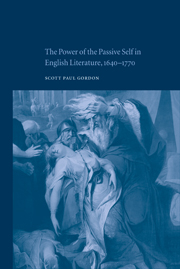Book contents
- Frontmatter
- Contents
- Acknowledgments
- Introduction. “Spring and Motive of our Actions”: disinterest and self-interest
- 1 “Acted by Another”: agency and action in early modern England
- 2 “The belief of the people”: Thomas Hobbes and the battle over the heroic
- 3 “For want of some heedfull Eye”: Mr. Spectator and the power of spectacle
- 4 “For its own sake”: virtue and agency in early eighteenth-century England
- 5 “Not perform'd at all”: managing Garrick's body in eighteenth-century England
- 6 “I wrote my Heart”: Richardson's Clarissa and the tactics of sentiment
- Epilogue: “A sign of so noble a passion”: the politics of disinterested selves
- Notes
- Bibliography
- Index
6 - “I wrote my Heart”: Richardson's Clarissa and the tactics of sentiment
Published online by Cambridge University Press: 22 September 2009
- Frontmatter
- Contents
- Acknowledgments
- Introduction. “Spring and Motive of our Actions”: disinterest and self-interest
- 1 “Acted by Another”: agency and action in early modern England
- 2 “The belief of the people”: Thomas Hobbes and the battle over the heroic
- 3 “For want of some heedfull Eye”: Mr. Spectator and the power of spectacle
- 4 “For its own sake”: virtue and agency in early eighteenth-century England
- 5 “Not perform'd at all”: managing Garrick's body in eighteenth-century England
- 6 “I wrote my Heart”: Richardson's Clarissa and the tactics of sentiment
- Epilogue: “A sign of so noble a passion”: the politics of disinterested selves
- Notes
- Bibliography
- Index
Summary
Few eighteenth-century bodies display the results of the difficulty with which eighteenth-century readers and writers credit disinterested behavior more than Clarissa's. Readers in and of Richardson's Clarissa (1747–48) have portrayed her body as fundamentally rhetorical, its visible signs (blushes and tears) and its literary productions (letters) designed to persuade audiences. After Pamela (1740) had in the spring and summer of 1741 provoked the same phenomena, Richardson complained that “anti-Pamelist” texts had his “whole Purpose inverted” – depicting both his heroine and Richardson himself as cunning manipulators rewarded not for virtue but for calculated deception. If these critics position Pamela's letters less as transparent transcriptions of her heart (“I wrote my Heart,” she claims) than as instruments of persuasion, her “Behavior” less as “artless and innocent” than as that “of an hypocritical, crafty Girl … who understands the Art of bringing a Man to her Lure,” they warn as well that Richardson's “Art” exactly mirrors Pamela's. Richardson “very artfully work'd up” his story to titillate male and female readers – “How artfully has the Author introduced an Image that no Youth can read without Emotion!” – and, like Pamela, “Cloaks” his texts in virtue only to further his interests, to seduce readers and snare a healthy reward. The storm over Pamela showed the ease with which any text can be absorbed into a discourse of universal self interest, “depreciated and debased” in Richardson's phrase, by those whom I call “Mandevillian (mis)readers.”
- Type
- Chapter
- Information
- The Power of the Passive Self in English Literature, 1640–1770 , pp. 182 - 211Publisher: Cambridge University PressPrint publication year: 2002



